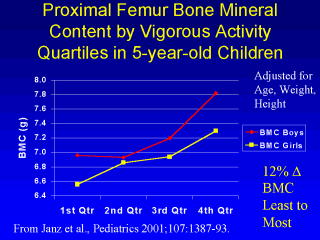| front |1 |2 |3 |4 |5 |6 |7 |8 |9 |10 |11 |12 |13 |14 |15 |16 |17 |18 |19 |20 |21 |22 |23 |review |
 |
Using a
questionnaire and accelerometry to quantify physical activity, my colleagues and I (56)
have recently shown the relationship between habitual physical activity and bone measures
in 368 young children (mean age 5 years). Physical activity was consistently associated
with aBMD and BMC. It explained 12% difference between the least and most active subjects
in bone mass of the proximal femur (11). When measuring physical activity in bone related studies, accelerometry is a good choice since weight-bearing movement is an important bone-related dimension of physical activity that is not easily captured with other measurement techniques. When positioned over the hip, an accelerometer directly measures the displacement of the hip. As stated earlier, the hip (proximal femur) is one of the most important skeletal sites to study since it is the most debilitating site for osteoporotic fractures. 11. Janz KF, Burns TL, Torner JC, Levy SM, Paulos RP, Willing MC, Warren JJ. Physical activity and bone measures in young children: The Iowa Bone Development Study. Pediatrics 2001;107:1387-1393. |